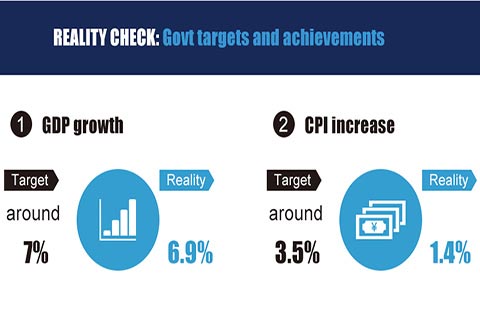China on track to build world's largest green bond market
By Cecily Liu (chinadaily.com.cn) Updated: 2016-03-04 22:27China is on track to build the world's largest green bond market and its efforts accelerate and harmonize the market through its G20 leadership this year is being keenly endorsed by industry players.
With a significant commitment to combat climate change, experts estimate China may reap 1.5 trillion yuan ($230 billion) for renewable energy and environmental projects within the next five years. In 2015 the global green bond market was worth only $46 million, and was only created in 2008 when the World Bank issued the first green bond.
Green bonds are bonds issued to finance environmentally-friendly projects, and are expected to revamp the global financial industry by realigning investor risk-return expectations with environmental objectives.
Because green bonds fund projects that are promised to be risk-adverse to tighter environmental regulation and changing energy costs in the long term, they are attractive especially to pension funds and sovereign wealth funds which typically take a long-term view of investments.
"Green bonds represent a change of dialogue. In a normal bond, you talk about the end result, rating and price, which are reflections of financial management, financing pricing and risk management. In green bonds you also talk about projects, conviction and mission," says Christopher Flensborg, head of sustainable products and product development at the Stockholm-based SEB bank.
"The dialogue surrounding green bonds is how to mitigate environmental risks for the long term by navigating around environmental standards. China has already demonstrated that green bonds can have lower costs to issuers, as these bonds get better slot times for issuers,"
China's domestic green bond market officially took off in December when Shanghai Pudong Development Bank Co raised 20 billion yuan of green bonds. Investor demand was so strong that Shanghai Pudong had offers to buy twice the value of securities it sold. This was shortly followed by Industrial Bank's issuance of 10 billion yuan of green bonds in January.
"The two banks' bonds not only attracted great investor interest but also a highly diversified investor base, and their interest rates also reached a record low amongst bonds with the same credit rating and maturity period," said Wang Yao, deputy secretary general of Green Finance Committee of China Finance and Banking Society,which is under the leadership of People's Bank of China.
Wang is also director of the Research Center for Climate and Energy Finance at the Central University of Finance and Economics, a think tank which provided certification to the Industrial Bank bond issue using the Chinese standards as a guideline.
To further grow China's green bond market, the Chinese government issued detailed standards for green bond certification to give bond issuers a clearer vision on projects considered to be green and due diligence standards which the issuance must meet to satisfy green bonds criteria.
In addition, the China Council for International Cooperation on Environment and Development issued a recommendation in November for the Chinese government to set up a National Green Investment Fund with a goal of reaching 300 billion yuan as a part of its 13th five year plan, to be announced in March.
Nick Mabey, chief executive and a founder of Third Generation Environmentalism, a London-based think tank, said such a fund would greatly accelerate the channeling of private sector investments into China's green finance sector in the same way the UK's Green Investment Bank works.
"It works by funding crucial environmental projects that are expected to generate high return, but are difficult to attract private money at preliminary stages because of perceived large initial risks," says Mabey, whose team helped the UK government establish its Green Investment Bank in 2012, which was first of its kind.
Globally, the first green bonds were issued by the World Bank in response to demand from Scandinavian pension funds. Since then, green bond issuances have taken off, with issuers including household names like Unilever, EDF and Toyota.
The market is expected to reach a new acceleration path following the Paris conference on climate change (COP21) in November when national leaders agreed to keep temperature rise this century to below 2 degrees Celsius. This new consensus suggests a new regulatory environment that gives incentives for clean energy projects financially and makes green bonds much more attractive for investors.
China's milestone announcement under the COP21 framework to hit the CO2 emissions peak by around 2030 and slash CO2 emissions per unit of the Gross Domestic Product by 60-65 percent from the 2005 level point to even higher potential for its domestic green bonds market.
"China has tremendous opportunities to continue the path of greening its economy and support low carbon and sustainable development. There is good energy and momentum behind trying to find ways to fulfill promises made at COP21, and investors are keen to be engaged and participate," says Heike Reichelt, head of investor relations and new products at the World Bank.
According to China's Financial Research Institute at the State Council's Research Center, the country needs 2.9 trillion yuan of investment annually in the next five years to support its green energy ambitions. Of these, potentially 300 billion a year could be funded by green bonds, according to the think tank.
Besides growing China's domestic green bond market, the emergence of renminbi-denominated green bonds in offshore markets is also playing an important role in helping China to reform and open up its capital markets, and internationalize the renminbi.
The first renminbi offshore green bonds are issued by the International Financial Corp, a World Bank organization, in London, raising 500 million yuan in 2014. China's PBoC issued its first offshore green renminbi bonds in London in October, raising 5 billion yuan, and the Agricultural Bank of China issued 600 million yuan also in London in October.
Green bonds can also be a vehicle to channel financing into infrastructure projects in China and other Asian countries, says Huo Rongrong, Global Head of China and RMB Business for Capital Financing at HSBC. The bank acted as sole lead manager on the IFC renminbi green bond, and was joint global coordinators for PBoC bond.
Global funds that invest in green bonds issued in China will help with the process of renminbi's onshore and offshore activities, another key element of China's capital market liberalization and renminbi internationalization, Huo says.
"China has played a key role in the formation of new multinational institutions like the Asian Infrastructure Investment Bank and the BRICS Development Bank, so new opportunities abound for these organizations to raise green bonds to fund infrastructure deals," Huo says.
The China-led AIIB, for example, has identified "Lean, Green, Clean" as distinct characteristics that will guide the bank's funding of projects.
"As these infrastructure projects are committed to long term environmental sustainability, they are suitable projects to be funded by green bonds, and the potential scale of these projects will help to grow the international green bond market to a new level," Huo says.
Whilst momentum behind green bonds is fast building up, the industry should now look beyond at the green finance picture holistically, says Huo. "We must not forget that money should flow to where it is needed most. It is therefore critical that the green agenda is closely linked with global infrastructure needs and reform."
To contact the reporter: cecily.liu@mail.chinadailyuk.com
- Beijing's property price expected to rise further this year
- Stefano Domenicali to take top job at Lamborghini
- Lamborghini unveils Centenario at Geneva motor show
- Falling forex reserves expected: PBOC's vice-governor
- Virtual reality cameras in spotlight at the two sessions
- Pony Ma tackles hot issues at news conference
- Canon hopes small markets will make big impact in China
- Yuan's large depreciation impossible, says economist
















